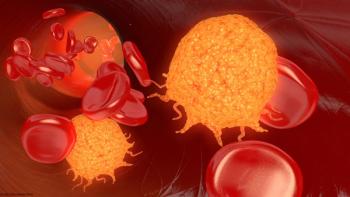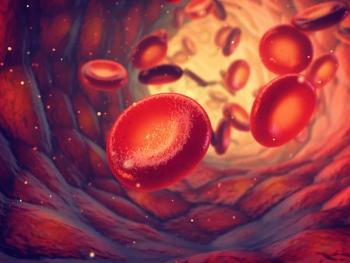
Second-Line Tarlatamab Improves PFS, OS in Small Cell Lung Cancer
Data from DeLLphi-304 support tarlatamab as a preferable second-line therapy for patients with small cell lung cancer.
Statistically significant and clinically meaningful progression-free survival (PFS) and overall survival (OS) improvements occurred in patients with small cell lung cancer (SCLC) who received second-line tarlatamab-dlle (Imdelltra), according to a presentation on primary analysis data from the phase 3 DeLLphi-304 trial (NCT05740566) at the
Findings showed that at a median follow-up of 11.2 months for patients treated with tarlatamab (n = 254) and 11.7 months for those given chemotherapy (n = 255), tarlatamab led to a median OS of 13.6 months compared with 8.3 months for chemotherapy (HR, 0.60; 95% CI, 0.47-0.77; 2-sided P < .001).1 In the tarlatamab arm, the 6- and 12-month OS rates were 76% and 53%, respectively. These respective rates were 62% and 37% in the chemotherapy arm.
“Taking the efficacy and safety data together, these data clearly support tarlatamab as a preferable therapy for patients in the second-line setting for SCLC,” lead study author Charles M. Rudin, MD, PhD, said in a presentation of the data. “Beyond redefining the standard of care for these patients, this study also establishes a new paradigm for the use of bispecific, T-cell engager immunotherapies for our patients with lung cancer.”
Rudin is deputy director of the Cancer Center, co-director of the Druckenmiller Center for Lung Cancer Research, and the Sylvia Hassenfeld Chair in Lung Cancer Research at Memorial Sloan Kettering Cancer Center in New York, New York.
In May 2024, the FDA has granted accelerated approval to tarlatamab for the treatment of patients with extensive-stage SCLC with disease progression on or after platinum-based chemotherapy.3 This regulatory decision was supported by data from the phase 2 DeLLphi-301 trial (NCT05060016).
DeLLphi-304 Background
The open-label, randomized, controlled study enrolled patients at least 18 years of age with histologically or cytologically confirmed SCLC who experienced disease progression following a first-line, platinum-based regimen with or without an immune checkpoint inhibitor.1 Patients were required to have an ECOG performance status of 0 or 1. Patients with asymptomatic, previously treated or untreated brain metastases were allowed to enroll.
Investigators randomly assigned patients in a 1:1 fashion to receive tarlatamab or chemotherapy comprising lurbinectedin (n = 47), topotecan (n = 185), or amrubicin (n = 23). Stratification factors included prior treatment with a PD-(L)1 inhibitor (yes vs no), chemotherapy-free interval (<90 days vs ≥90 days to <180 days vs ≥180 days), brain metastases (yes vs no), and intended chemotherapy (topotecan/amrubicin vs lurbinectedin).
OS served as the trial’s primary end point. PFS and patient-reported outcomes (PROs) were key secondary end points. Other secondary objectives included objective response rate (ORR), duration of response (DOR), disease control rate, and safety.
At baseline, the median age was 64 years (range, 20-86) in the tarlatamab arm vs 66 years (range, 26-84) in the chemotherapy arm. The majority of patients in both arms were male (tarlatamab, 72%; chemotherapy, 66%), were White (60%; 55%), were current or former smokers (91%; 88%), had an ECOG performance status of 1 (67%; 68%), received prior anti–PD-(L)1 therapy (71%; 71%), and received prior radiotherapy (63%; 63%). A chemotherapy-free interval of less than 90 days was most common in both arms (43%; 45%), followed by at least 90 days and less than 180 days (33%; 31%), and at least 180 days (24%; 25%).
Brain metastases were present in 44% of patients in the tarlatamab arm vs 45% of patients in the chemotherapy arm. The rates of patients with liver metastases were 33% and 37%, respectively. Among evaluable patients, 95% in the tarlatamab arm (n = 217) and 93% in the chemotherapy arm (n = 214) were positive for DLL3 expression.
More Efficacy, PRO, and Safety Data
Findings also demonstrated that the median PFS was 4.2 months for the tarlatamab arm vs 3.7 months for the chemotherapy arm (HR, 0.71; 95% CI, 0.59-0.86; 2-sided P = .002). The 6-month PFS rates in the tarlatamab and chemotherapy arms were 31% and 23%, respectively; the respective rates at 12 months were 20% and 4%.
Patients in the tarlatamab arm achieved an ORR of 35% (95% CI, 29%-41%) compared with 20% (95% CI, 16%-26%) for those given chemotherapy. In the experimental arm, the rates of complete response, partial response, stable disease, and progressive disease were 1%, 34%, 33%, and 22%, respectively. In the chemotherapy arm, these respective rates were 0%, 20%, 44%, and 20%. Ten percent and 16% of patients in the tarlatamab and chemotherapy arms, respectively, were not evaluable for response.
The median DOR was 6.9 months in the tarlatamab arm compared with 5.5 months in the chemotherapy arm. The respective 6- and 12-month DOR rates were 56% and 41% for tarlatamab compared with 29% and 13% for chemotherapy. The median time to response was 1.5 months vs 1.4 months for tarlatamab and chemotherapy, respectively. At data cutoff, response was ongoing in 47% of patients in the experimental group vs 15% of the control group.
Regarding PROs, the mean improvement in dyspnea score from baseline to week 18 was 1.94 in the tarlatamab arm vs –7.20 in the chemotherapy arm (difference, –9.14; 95% CI, –12.64 to –5.64; P < .001). At week 18, cough score improvements were reported in 16.1% of patients in the tarlatamab group vs 9.0% of patients in the control group (odds ratio [OR], 2.04; 95% CI, 1.17-3.55; P = .012). Improvements in chest pain at week 18 were reported in 8.7% and 3.5% of patients, respectively (OR, 1.84; 95% CI, 0.89-3.81; P = .100); differences in chest pain improvement did not reach statistical significance.
The median treatment duration was 4.2 months (range, <1 to 17) in the tarlatamab arm (n = 252) vs 2.5 months (range, <1 to 15) in the chemotherapy arm (n = 244). Any-grade treatment-emergent adverse effects (TEAEs) occurred in 99% of patients in the experimental arm vs all patients in the chemotherapy arm. The rates of any-grade treatment-related AEs (TRAEs) were 93% and 91%, respectively.
Grade 3 TRAEs were reported in 27% of patients in the tarlatamab group compared with 62% of patients in the chemotherapy group. The respective rates of serious TRAEs were 28% and 31%. TRAEs led to dose interruption and/or reduction in 19% of patients treated with tarlatamab vs 55% given chemotherapy. TRAEs led to treatment discontinuation in 3% and 6% of patients, respectively. One patient (0.4%) experienced a grade 5 TRAE in the tarlatamab arm compared with 4 patients (2%) in the chemotherapy arm.
In the experimental arm, treatment-emergent cytokine release syndrome (CRS) occurred during the first 2 cycles of tarlatamab in 60% of patients who were monitored for 48 hours (n = 209) at grade 1 (45%), grade 2 (13%), and grade 3 (1%). Nineteen percent of patients had serious CRS, and CRS led to treatment discontinuation in 0.5% of patients. The median time to intervention was 27 hours from the last tarlatamab dose.
In patients who were monitored for CRS for a minimum of 6 to 8 hours during the first 2 cycles of treatment with tarlatamab (n = 43), CRS was reported in 37% of patients at grade 1 (28%) and and in 9% of patients at grade 2. Seven percent of CRS instances in this group were serious, although none led to treatment discontinuation. The median time to intervention was 17 hours.
Although TEAEs such as CRS, dysgeusia, pyrexia, and decreased appetite were more common with tarlatamab, chemotherapy was associated with an increased incidence of anemia, neutropenia, thrombocytopenia, and decreased platelet counts compared with tarlatamab. The rates of grade 3 or higher TEAEs such as anemia, neutropenia, leukopenia, thrombocytopenia, febrile neutropenia, decreased platelet count, decreased neutrophil count, fatigue, pneumonia, and hyponatremia were all higher with chemotherapy vs tarlatamab.
Disclosures: Rudin reported serving in a consulting or advisory role with Abbie, Amgen, AstraZeneca, Auron Therapeutics, Daiichi Sankyo/UCB Japan, Disco, Earli, Genentech/Roche, Jazz Pharmaceuticals, and Merck; receiving institutional research funding from Daiichi Sankyo, Merck, and Roche/Genentech; and receiving royalties related to licensing of anti-DLL antibodies.
References
- Rudin C, Mountzios G, Sun L, et al. Tarlatamab versus chemotherapy (CTx) as second-line (2L) treatment for small cell lung cancer (SCLC): primary analysis of Ph3 DeLLphi-304. J Clin Oncol. 2025;43(suppl 17):LBA8008. doi:10.1200/JCO.2025.43.17_suppl.LBA8008
- Mountzios G, Sun L, Cho BC, et al. Tarlatamab in small-cell lung cancer after platinum-based chemotherapy. N Engl J Med. Published online June 2, 2025. doi:10.1056/NEJMoa2502099
- FDA grants accelerated approval to tarlatamab-dlle for extensive stage small cell lung cancer. FDA. May 16, 2024. Accessed June 2, 2025. https://www.fda.gov/drugs/resources-information-approved-drugs/fda-grants-accelerated-approval-tarlatamab-dlle-extensive-stage-small-cell-lung-cancer
Newsletter
Stay up to date on recent advances in the multidisciplinary approach to cancer.


















































































